#original painting is coronation of the virgin
Explore tagged Tumblr posts
Text
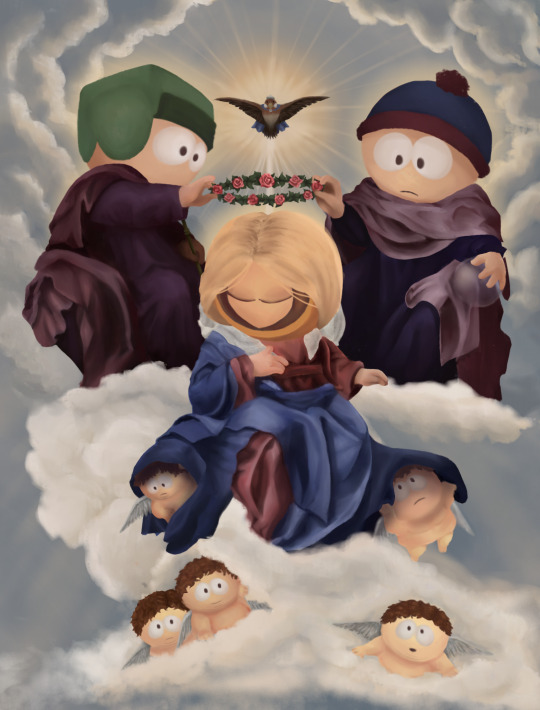
coronation of the kenny
this was made on my moms request
#south park#kenny mccormick#south park fan art#fanart#sp fanart#stan marsh#kyle brovlofski#eric cartman#my art#original painting is coronation of the virgin#kyle is jesus#stan is god#and cartman is the cherubs#and ofc princess kenny is the virgin mary#this is a joke i spent like 30 hours of my life on#also peep the sparrow prince
593 notes
·
View notes
Text

Queen Elizabeth in Coronation Robes
Artist: Old Master
Genre: Portrait
Date: circa 1600
Medium: OIl on Panel
Collection: National Portrait Gallery, London
Description
Queen Elizabeth I of England in her coronation robes, patterned with Tudor roses and trimmed with ermine. She wears her hair loose, as traditional for the coronation of a queen, perhaps also as a symbol of virginity. The painting, by an unknown artist, dates to the first decade of the seventeenth century (NPG gives c.1600) and is based on a lost original also by an unknown artist.
#portrait#queen elizabeth i#coronation robes#old master#c. 1600#national portrait gallery#tudor#english monarch#european#tudor roses#ermine#crown#cape
5 notes
·
View notes
Text
But in 1859, when Burne-Jones first stood before another Botticelli, The Coronation of the Virgin, this time in the Accademia, Botticelli was a very specialist taste. Of the original Pre-Raphaelite brothers only Rossetti appreciated him. Now Burne-Jones too saw Botticelli’s power as an artist. First of all he respected Botticelli’s workmanship, his sheer professional stamina, citing him as an example of the value of not ‘shirking’, leaving parts of a painting not properly completed: ‘Even M. Angelo shirks sometimes,’ he would say, ‘but Botticelli never; he thinks well about it before he begins and does what’s beautiful always.’ He appreciated Botticelli’s physical deliciousness, the sweetness of the detail. He remembered and described with an intense affection the round Botticelli painting of the Virgin and Child in the Pitti Palace ‘where the Virgin holds down a dear little face to kiss another fat face’. His response to Botticelli came very close to ecstasy: ‘no one is like him and never will be again’. He kept Botticelli with him, an ideal and a safeguard. In the bleaker years back home he kept on yearning to return to Botticelli like an old friend or a lover, with a growing desperation: ‘I want to see Botticelli’s Calumny in the Uffizi dreadfully, and the Spring in the Belle Arte, – and the Dancing Choir that goes hand in hand up to heaven over the heads of four old men, in that same dear place.’ He would look back on Florence with a painful nostalgia, not only for its paintings and sculptures but for the place itself. He liked the pattern of side streets leading into great piazzas, the austere calm of the monasteries, the squall and movement of the markets. He saw Florence as a city that was itself, in its contrasts and coherence, its tradition of craftsmanship, a living work of art. Burne-Jones felt the poignant charm of it, the everyday grace in such details as the stall selling gillyflowers and scented lilies beside a city gate. The rhythms of the city were imprinted on his consciousness. The idea of returning agonised and taunted him once he was back in London. ‘Oh dear when I think that this very morning Florence is going on and I have to go into that muddle of work upstairs.’
Fiona MacCarthy - The Last Pre-Raphaelite_ Edward Burne-Jones and the Victorian Imagination, p. 101
0 notes
Text
Coming back to say more.
The reasons as to why the artist's excluded the twins: "original idea was nyra and her biological children (and the workload would be too much I barely finished this one)". The two reasons seem unrelated and not informing each other. They are, though.
What the artist is actually saying is that they believed that the twins are themselves unworthy of being included because the artist believes that they do not believe any role in affirming Rhaenyra's authority, power, and legacy. Because blood ties trump emotional ones, or are the only ones that assure/secure an individual's significance and longevity.
Original Painting, Infants, and Mary
I already address how irrational, non-canon [not HotD, which is strictly itself anti-canon] and how shallow it was to focus only on "bio" children. Now the "workload" part. What does "bio" children matter so much here? It also has to do with Virgin Mary iconography, one type where the image of the Virgin Mary with the baby Jesus where she and the painting formula/image became known as "Madonna".

Image credit: "Madonna and Child", Julie Mihes, 1823
Any and all euro-central works with a mother and infant or toddler on her lap can be categorized as a Madonna, whether the artist or intention is religious or not, because some messages of the traditional Madonna are "mother's love", sacrifice, resurrection, and the metaphysical glory from those things.
Mary, mother of the Christian messiah/savior, is also known as the Queen of Heaven, one of her other monikers. The artist clearly draws from that moniker, but culturally on the most general sense you cannot separate the baby from Mary, as her purpose was to give birth and raise God's child, which was her sacrifice to the higher power.
Even in nonMadonna works where she is centered, as she is in Diego's work (below) she is known as the "Mother of God" and she would not be even noticed and marked for a legacy in Christian culture if she hadn't been Jesus' mother.

Which means that the artist of the Rhaenyra-Madonna purposely chose to include an element that didn't have to be included, but had a specific significance they wanted to express but deny to the twins.
The Twitter Art and Blood vs Family
Visenya was a good addition...if they hadn't gone the "bio" route, and so it entails that they thought Visenya was important enough to add to buttress Rhaenyra's legitimacy and power. Visenya being there is what I liked about the art apart from the manner of line, rich colors, and shapes they chose.
I also like the irony in the reverse switchup and attempt at subversion of the Madonna figure -- with the theme of love by reinserting a baby figure through Visenya and making her (what would have been the baby Jesus/the end-all, be-all) the means to center Rhaenyra, the newish focal point. This baby that, unlike Christ, will not live to see adulthood, but like Christ will die through a sort of tragedy and violence. And unlike Christ, Visenya will not really "save" anyone so much as inspire Rhaenyra more to start a war that will take multiple lives AND still right a wrong down against her/women in power. They did something a little different by making Visenya more a symbol of Rhaenyra's power with the baby turned towards her, away from the viewer, unlike traditional Madonna. And her husband/other bio kids replace the angels and putti of the original "Coronation". Which signals to us, the viewers, that like Mary, Rhaenyra draws her strength, meaning, legitimacy, and power from her children and husband. From her immediate family.
And since we know that the Targaryens are all descended from Rhaenyra through her son Viserys II, that Dany comes from this line, that lineage is very central and defining in the canon, this also in the painting.
However, the ASoIaF story -- of which Rhaenyra plays a huge part through her story's feminist connection to Dany's rise of power and characterization and the focus on how queens better the lives of their people in some way (Alicent would not) -- does not convey that only blood connections matter or actually secure neither ove nor political power. In fact, the entire series continuously resists against and deconstructs the fixation on "blood" and biological family.
As we see that through the Lannisters, Cersei's abuse of her kids, the Greyjoys, Dany vs her brother Viserys vs her relationship with Missandei, Jaehaerys and Alysanne and their kids or Jaehaerys vs Rhaena, etc. It's not that simple.
Even in Rhaenyra's family/time, blood connections don't mean enough to merit the artist's insistence on biology and blood connections. I already showed in my Twitter response and the pics in the original Tumblr post above, how Rhaenyra's stepdaughters are already very blood connected to her by being her first cousins, and in line with the motif of motherhood, they would have been the mothers of her grandchildren/heirs/the future rulers of Westeros. She should feel close or develop a relationship with her siblings, but they despise her for not conforming to Westerosi patriarchal mores of female obedience and chastity. And by Westerosi patriarchal custom, Rhaenyra's first three children (if there was ever a way to reveal that they are biologically not Laenor's, which there isn't) would be seen as not relevant to be included in the Targ lineage without public legitimization. The idea is that biological trueborns children are the only "true", real, blood. After centuries of secular distrust and stigmatization of bastard children (those born out of wedlock), the Faith -- which is modelled and systematically takes after real medieval Christianity -- also condemns bastards as "born from lust, lies, and weakness, and as such, they are said to be wanton and treacherous by nature."
We cannot separate art, especially medieval/medieval-like art from history, biological connection, feudal focus on lineage, and trueborn vs bastards. Even when the artist makes clever changes and even modifies the pairing in from its cultural origins and symbolism enough, that is still coming from a culture with all sorts of symbols, history, and roles that contextualize and give the work its meaning in the first place for it to work away from. Change/adaptation =/= total destruction.
To Rhaenyra's family has largely assimilated into Westerosi culture and patriarchy (to their own detriment, but that's a different story concerning Jaehaerys I) and put aside many Valyrian customs aside from sibling marriage. The Targs mimic the Westerosi Kings' monarchial form of absolute monarchy and rule as absolute monarchs. And they maintain(ed) power through lineage and raising children born in wedlock so those kids (sons or even uncles and nephews if no child/son is available) is found will have an unobstructed avenue to ascension after the monarch's death. And Andal/Westerosi custom has mead it so that women are mentally, physically, and sexually restricted from childhood in order to "ensure" that any child they had could be "trusted" to be their assigned husband's. A way for men to know other men have no ties and avenue to their power and authority.
However, from the very beginning, she had her extramarital and premarital affairs/trysts and proactively made her own way to power after Viserys (unlike Jaehaerys I) gave her that privilege. Since there are no such thing as "rights" in feudalism, only claims and privileges.
Rhaenyra also did not put care to blood connections enough for her to consider the twins not her own or to disregard her Velaryon sons. Her first set of sons flout the rules of placing precedence on bio connections and blood. They are not Laenor's, but Laenor, Viserys, and Corlys all accept them and consider them family. This enables Rhaenyra to form her family. And her first three boys, if we are going to be so strict about "bio", blood kids, also should not even be in the artist's work. If we were to follow their logic.
The twins lived with book!Rhaenyra for 10 years, 6 in the show. They were raised by her, Daemon, and Laena. They also already protect(ed) and support(ed) Rhaenyra's bio children with their very lives in the war and provided him with a wife that could not be controlled by Unwin Peake, who sought to Aegon III's position as the vulnerable minor for his own purposes, often against Aegon's expressed wishes. Without these twins, Aegon may not have been able to rule as confidently as he was able after seeing Rhaenyra die until his children and his brother, Viserys II, ascended to the throne. And again, it is through Viserys II that we have Dany today.
And if we are supposed to criticize the Westerosi patriarchy and misogyny, it's hatred and disregard towards children born out of wedlock...why does the artist then rely back on the cultural significance of "real", "true", bio blood? Why does the artist ignore or is ignorant of GRRM's purposeful deconstruction of family-by-blood and truebornness, what "legitimacy" means, in the various stories told about full-blood, bio family choosing to degrade each other? Why are we still dependent on the Westerosi definition of "family", and thus also motherhood and womanhood, when the subject in question flouted the traditions for her own path to power? Why are we regressing?
The artist ended up ignoring Rhaenyra's characterization and reduced her entire arc by denying her connection with Baela and Rhaena. They think they are serving Rhaenyra, when they aren't.
And they revealed a bias against Rhaena and Baela that not only doesn't make sense (as most biases and prejudices don't) considering the Velaryon boys, they ended up perpetuating the oppressive cultural demand for biological="real", revealing another hidden prejudice that is actually not a all disconnected from the other because both are based on blood purity.
Found this piece of art on Twitter:

Now you may ask, "Where are Baela and Rhaena?"
This was the artist's response:
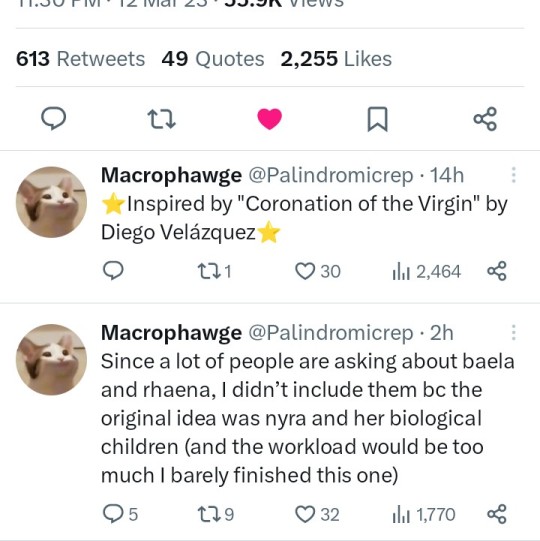
And this is my thought towards that:
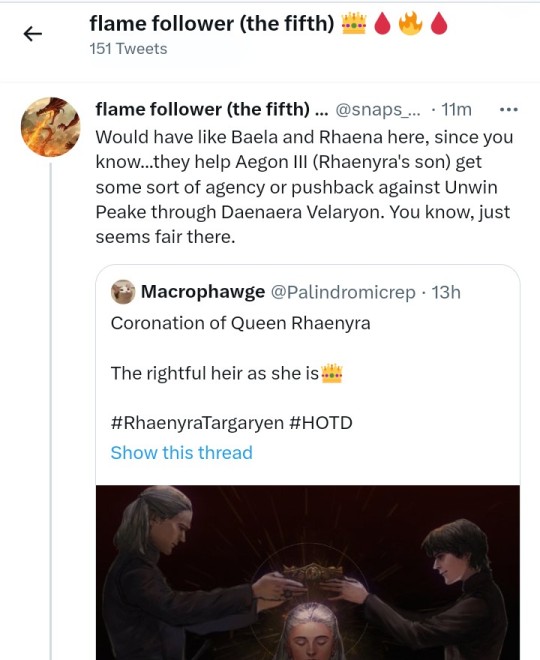

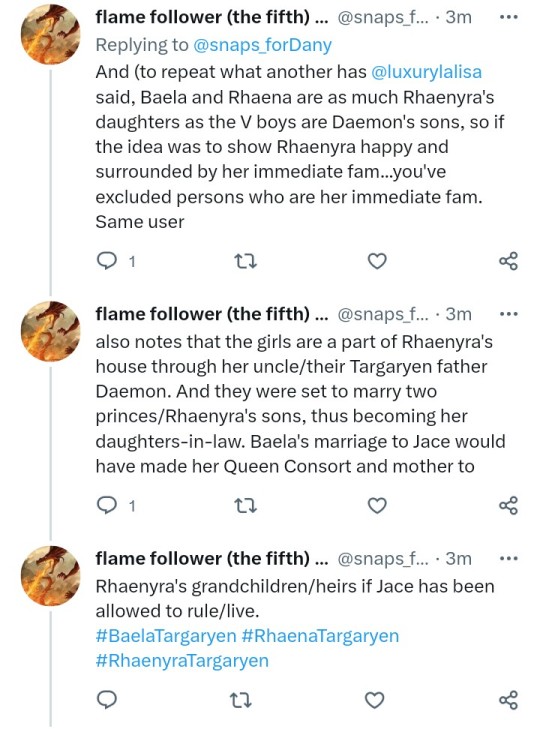
Just goes to show how Baela and Rhaena have been relegated to the side for not being the "right" sort of Targaryens by even the black fans of this series. (Double irony through puns)
Then when we see those criticisms of the artwork, you see people who come to the artist's defense:

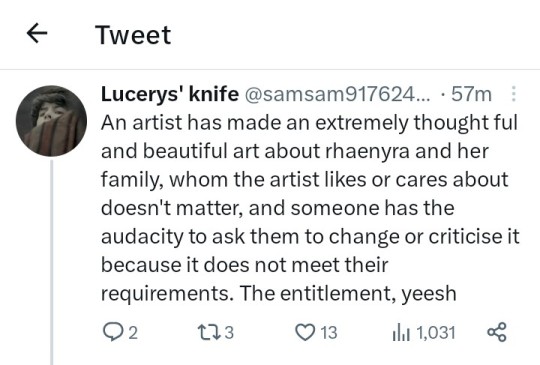
I already pointed how how the artwork was conceptually lacking and how this lack made the artwork doubly discriminatory and unfair.
But it's strange to see these people defend the lacking based on...."manners" as if we should wholesale swallow messages of art and literature without any sort of criticism. These people did not bother to consider if said Criticisms were constructive or had points, they immediately went: it's the artist's prerogative to have their work unanalyzed or criticized (even though they published it themselves) in any way (that's the rub) just because they worked hard on it. The immediacy of the shut down comes with a flawed judgement, becoming something like censorship itself.
Was Twitter a mistake?
#hotd twitter#rhaenyra's children#rhaenyra and daemon's children#daemon's children#baela and rhaena#baela targaryen#rhaena targaryen (daemon's daughter)#rhaena targaryen#asoiaf#a song of ice and fire#hotd#house of the dragon#medieval history#medieval art
86 notes
·
View notes
Photo
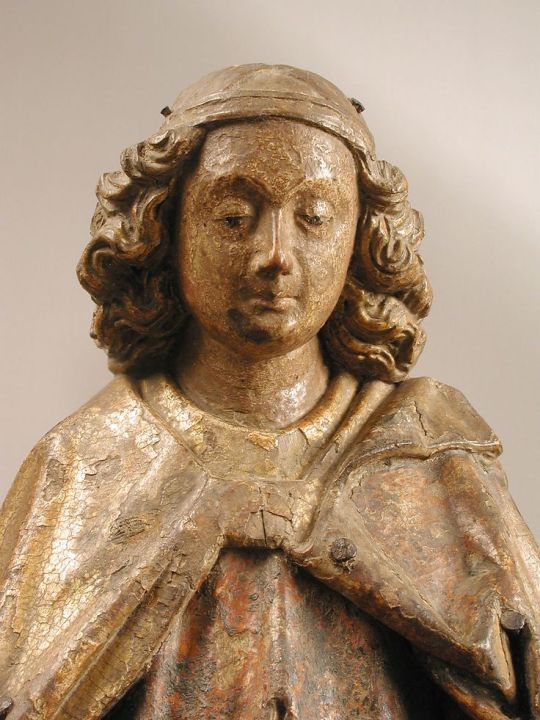
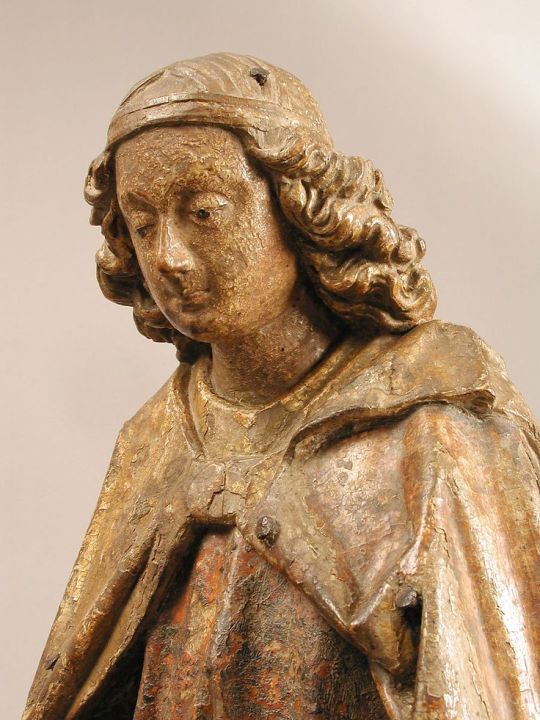
Angel, detail, ca. 1460–80, German, Wood, gilded and painted - This wingless angel playing a dulcimer probably accompanied an angelic orchestra in a scene such as the Assumption or the Coronation of the Virgin. The angel originally held hammers for hitting the strings. - The Met
#angel#angelcore#angel aesthetic#german#statue#art#carving#wood carving#wingless angel#the met#metropolitan museum of art
3 notes
·
View notes
Note
When do you think Anne got her B necklace? Do you think she always had it or was it given to her later in life?
Oh I have so many thoughts about this!
So jewelery with initials or letters wasn’t uncommon, but what I find really interesting is how obvious the B is. A lot of times, when people would put initials in their jewelry it was kind of disguised. So the fact that the B is so distinguished makes me think Anne was trying to make a statement with it.
Also, the necklace itself is made of pearls and gold, which, in the 16th century, would’ve been really expensive. It’s possible she could’ve been given it as a gift from a wealthy friend, but if either she commissioned it for herself or was given it by a family member, the Boleyns probably wouldn’t have been able to afford jewelry like that until they were elevated to the peerage.
Since we have absolutely no idea when she could’ve acquired the necklace, it is possible she could’ve had it early on in life, but I think it’s more likely she didn’t have it until she was Queen (or maybe shortly before she was Queen). Yes, because it would’ve been expensive, but more importantly because of the first point I made.
Anne knew how to make statements with her clothing and style. Apparently she was known to wear her hair down and uncovered when that was not the norm. In fact, that’s how she wore her hair at her coronation—wearing your hair down was supposed to be a symbol of virginity and purity. At her execution, she wore a gable hood because the gable hood was a symbol of true Englishness and she was showing everyone that she was the Queen of England. So I think having this necklace with such a predominant B was meant to remind people of who she was and who her family was. If it’s true that the famous portrait of her is in fact a copy of an original painted during her Queenship then I think it says a lot that she wanted that necklace to be featured in her ‘official’ portrait essentially.
I like to think that maybe the necklace was, like, a coronation gift from George—I just think commissioning a necklace like that seems a very George thing to do.
52 notes
·
View notes
Photo




Our Lady of the Rosary of Chiquinquirá or the Virgin of Chiquinquirá is a Marian title of the Blessed Virgin Mary associated with a venerated image in the northern Andes region.
Under this venerated title, the image is the Patroness of Colombia, the Venezuelan state of Zulia, and the town of Caraz in Peru. The image is painted on a cotton support, is kept in the Basílica of Our Lady of the Rosary in the city of Chiquinquirá, in Colombia, where religious devotees celebrate her date every December 26 and July 9.
On 9 January 1910, Pope Pius X authorised the Canonical Coronation of the image of Our Lady of Chiquinquirá in Colombia, which was not carried out until 9 July 1919 due to the political turmoil prevalent at the time. On 3 July 1986, Pope John Paul II visited the sanctuary and prayed for peace in Colombia at the feet of the Virgin Mary's image. The title given to the Virgin is from the city of Chiquinquirá, where the first of the Virgin's miraculous manifestations occurred, and where the original image from the sixteenth century is kept.
In 1562, the curator of the city of Suta, Antonio de Santana, requested that Alonso de Narvaez paint a picture of the Virgin of the Rosary – who would be venerated in his chapel. The artist used as paint mixtures of the earth with different colours and the juice of some flowers and herbs.
As a canvas, a cotton blanket was used. Next to Our Lady, on her right, he painted St. Anthony of Padua, and on her left St. Andrew the Apostle. When completed, the work was exhibited for the veneration of Spaniards and Indians, at the altar of the chapel of Suta.
Due to lack of care and leaks in the ceiling of the chapel, with time, the picture deteriorated. In 1578, when the presbyter Juan Alemán de Lequizamón assumed the position of curator, he removed the painting from the chapel for not considering him worthy and returned it to his owner, who sent the work to his farm in Chiquinquira.
After the death of the curator Antonio Santana, in 1582, his widow Catalina García de Irlos went to live in this farm. A relative of the deceased, Maria Ramos Hernández, found the painting totally discoloured, worn and dirty.
Maria decided to clean it, to frame it and to hang it in the chapel of the farm. Every day she prayed in front of the painting saying:
“Until when, Rose of Heaven? How long must you be so hidden? When will the day come when you will manifest? “
On December 26th, 1586, the Christian Indian Isabel, along with her son Miguel, passed by the chapel, and the son said: “Mother, look at the Mother of God on the ground.” Then Isabel saw the Blessed Virgin with a glow that filled the chapel.
Addressing Maria Ramos, Isabel said, “Look, look, lady, that the Mother of God has come down from her place and is standing there on your seat, and it seems that she is burning.” Mary looked at the altar and saw the transformation that had taken place in the painting, “so lucid and renewed in cheerful and heavenly colours, that it was a glory to see it.”
The Virgin of the Rosary in the center of the painting is approximately three feet high. She looks towards her left as if to call attention to the nearly naked Child in her arms. The image has a calm countenance with a delicate smile. Both her face and the Child's are pale. The Child has a little brightly colored bird tied to his thumb and a rosary hangs from his left hand. The Virgin is supported by a crescent moon in a position suggesting the woman of the Apocalypse. A white veil covers her hair and her rose-colored robe is covered by a sky blue cape. With the little finger of her left hand she holds a rosary which hangs in front of her, and in her right hand she has a scepter. On her right stands the figure of St. Anthony of Padua, and on her left that of the Apostle St. Andrew.
“Virgen del Rosario, Queen of Colombia, our Mother!
Pray for us now. Grant us the inestimable gift of peace, overcoming all hatreds, resentments and the reconciliation of all our brothers and sisters.
Let the violence cease, let the dialogue progress and consolidate, and let peaceful coexistence begin.
Those new paths of justice and prosperity be opened.
We ask you, whom we invoke as Queen of Peace.
Be for us the door of heaven, life, sweetness and hope, so that together we can glorify the Father, the Son and the Holy Spirit.
Amen”.
14 notes
·
View notes
Text
Las Lajas Sanctuary




Las Lajas Sanctuary is located in southern Columbia in the municipality of Ipiales, South America. The gothic revival church was built in 1916-49 on a stone slab in the middle of the Guiátara river canyon. The local authorities and residents financed the project. An earlier straw and wood shrine once sat upon the site, with a larger shrine built in 1802. The church is also referred to as the National Shrine Basilica of Our Lady of Las Lajas or Las Lajas Shrine. The Roman Catholic Church sits on a 130 feet tall bridge over the Guiátara river. The castle boasts a mysterious mural of unknown origins and is known for a series of legends involving the appearance of the Virgin Mary. The unknown mural is portrayed on rock and depicts the Blessed Virgin Mary holding baby Jesus, with St Francis and St. Dominic praying. The most interesting part of this mural is the core samples taken by geologists claim there’s no paint, dye, or pigment used to create the image, and the colors come from the colors of the rocks. Amazingly, the rock is colored to a depth of several feet. Lajas Sanctuary received a canonical coronation from the Vatican in 1952 and was made a minor basilica in 1994. The church has wooden pews, stained glass windows, statuary, and plaques left by those making a pilgrimage to the church. The church is free to enter, but there is a charge for the museum.
9 notes
·
View notes
Text
CUSTOMS AND TRADITIONS
by Itzel
Every country has customs and traditions that distinguish them from the rest of the world, and Mexico is no exception. Throughout the year, you will find festivities full of music, dance and color with deep meaning and strong cultural roots. Mexican traditions have survived the passage of time, some have been transformed, mixed with customs from other states or countries but rescuing and preserving their essence. Here is everything you need to know about the most popular Mexican traditions, which you should not miss.
1. Day of the Dead
If there is one thing that sets Mexico apart, it is the way we honor our dead. This tradition takes place on November 1 and 2 of each year. The Day of the Dead fills the streets of every city and municipality, and Mexican homes with color.
Honoring and showing respect to the dead is a custom that has been passed down from generation to generation. There are variations of this tradition in each region, such as the Hanal Pixan, a unique tradition in the Yucatan Peninsula.
Visiting the graves of the deceased, cleaning the tombs and decorating them with flowers are some of the traditions of this celebration, but without a doubt, one of the most outstanding customs is to place an altar that welcomes the deceased who visit us on these dates.
During these dates you can find great cultural richness and taste the special food of the country.

2. La Guelaguetza in Oaxaca
La Guelaguetza, also known as ¨Los lunes del Cerro¨, is the most important holiday in Oaxaca. This is a celebration full of music, color and joy, which takes place on the two Mondays following July 16th.
The Guelaguetza, with religious origins, began as an indigenous celebration dedicated to Centéotl, the goddess of tender corn. After the Spanish Conquest, this celebration became a Catholic rite performed in honor of the Virgen del Carmen.
The Guelaguetza gathers representatives from the eight regions of Oaxaca, who take the Cerro Fortín to perform their traditional dances, typical costumes and great gastronomic variety.
Over the years, the Guelaguetza has become more popular, extending its festivities with activities that satisfy all tastes. Cultural events, dances, gastronomic demonstrations and concerts by artists of the moment are some of the activities you can enjoy.
Some of the dances that are performed on the Lunes de Cerro are the Sones Serranos, the Jarabe Mixteco, the Danza de la Pluma, the Sandunga and the Danza Flor de Piña.

3. The Papantla Flyers
The Papantla Flyers are known all over the world. Their dance takes place in the city of Papantla, Veracruz but it is not the only region where it is performed.
This ritual dates back to pre-Hispanic times and although it has been modified over time, it retains its original meaning.From the beginning this event is part of the merit rituals, in which they sought to obtain prosperity and a long life.
The ritual begins when the leader of the dancers goes into the forest in search of the best tree to perform the dance.It is necessary to clean the land so that when the tree falls, its structure is not damaged. Once on the ground, the branches and foliage are removed to leave only the trunk.
The final part of the ritual is the well-known descent of the dancers suspended from a rope. This dance is an ancestral tradition that will undoubtedly surprise you.

4. Dance of the Parachicos in Chiapas
From January 8 to 23, the largest celebration in Chiapa de Corzo is held. The dance of the Parachicos was declared Intangible Cultural Heritage by UNESCO.
The most striking aspect of this festival is that you can see the dancers dressed in embroidered shawls, sarapes and colored ribbons, wooden masks and carrying tin rattles called chinchines which they play during the dances.
As in all the customs and traditions of Mexico, the best traditional dishes and drinks cannot be missed.

5. Parade of Alebrijes in CDMX
It is a recently created event which has had an excellent acceptance. The Alebrijes Parade has been held since 2007 and is organized by the Museum of Popular Art with the help of several institutions.
Albrijes are an icon of Mexican culture and have their origin in the early 20th century. The artist Pedro Linares, who was famous for his ability to create carnival masks and other paper mache works, became ill with a fever that caused him to have many vivid dreams bringing these unique and colorful figures to life.
The parade starts in the Zócalo of the city and you will be able to admire paper mache figures, painted in brilliant colors, up to 4 meters high. The parade can look like a carnival when accompanied by musicians, clowns, costumed people and more.
At the end of the parade the figures are displayed in the Paseo de la Reforma. Afterwards, the alebrijes are judged and prizes are awarded to the artisans.

6. Carnival of Veracruz
Although this festivity takes place in many regions of the country, the carnival of Veracruz stands out for being the most famous in Latin America after the one in Rio de Janeiro.
Some of the events are the coronation of the carnival kings, which takes place in the city's zocalo, and the "Quema del Mal humor" (burning of the bad mood), which starts the festivities.
During the 9 days that this celebration lasts you will be able to admire how the streets of the city are filled with color and joy. There are parades of floats decorated with unique designs that will surprise you and are accompanied by dancers who wear colorful costumes.
The city is full of visitors who travel from other parts of the country willing to enjoy the joyful Jarocho atmosphere. To conclude the festivities, on the ninth day, the burial of Juan Carnaval takes place.

7. Holy Week
Holy Week, also known as Semana Mayor, is one of the best known religious celebrations in Mexico. This is the most important time for the Catholic community.
In spite of being a religious celebration, it is considered a national holiday, so it is common to see activities suspended at many levels of school, government and private areas.
This holiday period is considered one of the best times of the year to go on vacation with family and friends.
In the Catholic liturgical calendar, Lenten starts on February 14, on Ash Wednesday and ends on March 29, on MaundyThursday. In Mexico, religious processions and celebrations are the results of syncretism between ancient cultures and the Spanish. The mortification, sacrifice, and physical pain that take place during some of the representations of the Way of the Cross are used to express repentance, redemption, and fulfill promises.

8. Independence Day
Every year on September 16, Mexicans around the world celebrate Mexico's independence. It is one of the traditions that best represent the pride of being Mexican, and that is why every September is called the month of the nation.
On the night of September 15, Mexicans gather in the zocalo of each city or in their homes. Outside the country, Mexicans in different parts of the world do not let this day go by and they also gather to celebrate.
The main event of the night is the famous ¨Grito of Independencia¨ simulating what Father Hidalgo did on September 16, 1810. The President of the Republic is in charge of making this representation at a national level and in each city and municipality it is replicated by the rulers in turn.
During this celebration you will be able to enjoy the traditional Mexican food stands, mariachi music, concerts by artists of different genres and, of course, the fireworks shows cannot be missed.

9. Day of the Virgin of Guadalupe
In Mexico, the Catholic religion is deeply rooted in our culture. The celebrations around the day of the Virgin of Guadalupe start the December festivities known as the Guadalupe-Reyes Marathon.
The celebration takes place on December 12 as it is the date of the last apparition of the Virgin to San Juan Diego on the Tepeyac hill, according to Catholic belief.
On December 11, at 6:45 p.m., the celebrations begin with serenades and other tributes. At 12:00 am musicians and artists sing the traditional "mañanitas" to the Virgin.
During the day the churches and parishes see a great influx of people to attend the scheduled masses. In several places in the country, thousands of people go on pilgrimage to the Basilica of Guadalupe in Mexico City.
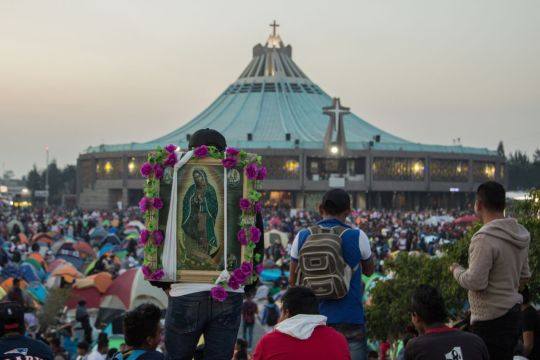
10. The Posadas
The posadas take place from December 16th to 24th. They are one of the most beautiful traditions in Mexico.
During the 9 days of the posadas, prayers are said and each one has a different meaning: humility, strength, detachment, charity, trust, justice, purity, joy and generosity.
By custom, a house is designated as the host for each day, and neighbors and family members organize to carry out these activities. After the prayers you can enjoy a conviviality where food and drink are offered to those attending and they can break the traditional piñata.
In the posadas, it is customary for participants to blindfold themselves to break the piñata, which is made of baked clay or cardboard and is decorated with colorful paper mache.
Today, piñatas accompany all kinds of festivities and are not limited only to the posadas.
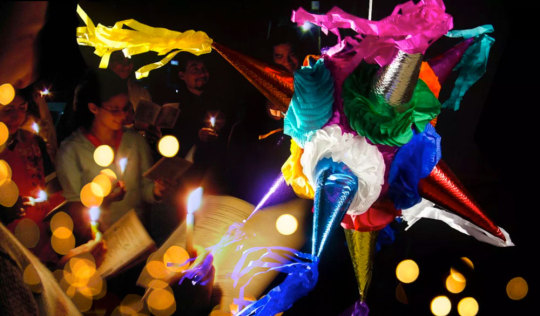
11. Epiphany or Three Wise Men's Day
It is a religious holiday celebrated in Mexico on January 6 to commemorate the arrival of the Three Wise Men in Bethlehem to worship the baby Jesus.
Don't miss out on the wide variety of bagels that are baked: try the different types of fillings and toppings that you will love.
The rosca de reyes hides inside one or more plastic dolls representing the baby Jesus. The custom dictates that whoever finds one of these dolls must present the baby Jesus in church and invite his family and friends to eat tamales on February 2nd, better known as La Candelaria's day.
10 notes
·
View notes
Photo

Michael Pacher - St. Wolfgang Pilgrimage Church Winged Altar - 1481
Michael Pacher’s most famous work, the St. Wolfgang Altarpiece, remains in its original location and setting in St. Wolfgang im Salzkammergut on the Abersee (the western end of lake Wolfgangsee) in Austria. The altarpiece is a polyptych, or Wandelaltar, where a painting is divided into four or more segments or panels. There are two pairs of movable wings, and three different displays for use on different occasions: an everyday display, a Sunday display, and a display for special holy days.
Commissioned for Abbot Benedict Eck of Mondsee in 1471 and completed in 1481, the giant polyptych has two sets of wings that can be closed across the inner corpus with the sculptured Coronation presenting a majestic array of huge Gothic figures dominated by the beautifully kneeling Madonna. The carved and painted gold centerpiece is visible when the inner panels are open, and shows the Coronation of the Virgin. The outer two pairs of painted wings represent four scenes of Saint Wolfgang. Wolfgang was appointed as bishop Benedictine of Ratisbon, where he established himself radiantly for his revolutionary passions and also for his skills as statesman.
The entire altarpiece is overshadowed by an elaborate wooden structure that is placed on top, enclosing the Crucifixion. In the centerpiece, Christ is sitting on a throne sincerely blessing Mary, whom he has crowned as the Queen of Heaven. In keeping with the traditions of German Gothic art, angels are fluttering around while John the Evangelist looks on. The inner faces of the second panels, on both sides of the carved body, are painted with scenes from the life of the Virgin.
Some scholars believe that Pacher was not the only artist who has contributed to this very large altarpiece. His brother Friedrich Pacher may have painted the outer pieces of work depicting scenes from the life of Saint Wolfgang that are visible only when the altarpiece is closed shut. Nevertheless, the inner paintings all seem to have been completed by Michael Pacher himself.
Michael Pacher (c. 1435 – August 1498) was a painter and sculptor from Tyrol active during the second half of the fifteenth century. He was one of the earliest artists to introduce the principles of Renaissance painting into Germany. Pacher was a comprehensive artist with a broad range of sculpting, painting, and architecture skills producing works of complex wood and stone. He painted structures for altarpieces on a scale unparalleled in North European art.
Pacher's masterpiece, the St. Wolfgang Altarpiece (1471–1481), is considered one of the most remarkable carved and painted altar shrines in all of European art. It contains scenes from the life of Jesus and the Virgin Mary. Pacher's other great work, the Altarpiece of the Church Fathers, created in 1483 for Neustift Monastery, combined painting and sculpture to produce a unique art form.
24 notes
·
View notes
Photo

Coronation of the Virgin, Christoffel Jegher, 1632-36, Cleveland Museum of Art: Prints
Peter Paul Rubens was as astute a businessman as he was a brilliant painter. He realized that substantial profit and fame could be derived from the publication of prints made after his paintings. He employed engravers and also Jegher, who made nine woodcuts after the master's work. While the engravings were always considered merely reproductive, the woodcuts were conceived and appreciated as original works of art because they exhibited the freedom and directness of expression lacking in the intaglio prints. Rubens revived the tradition of large-scale woodcuts, which had flourished in 16th-century Italy and the Netherlands but lagged in the following decades. Jegher's prints after Rubens are the only such large, single compositions in Flanders in the 17th century. They are also his most outstanding creations. Medium: woodcut
https://clevelandart.org/art/1925.149
1 note
·
View note
Text
I saw Frozen 2 and there’s a lot to say. I’m not gonna write in any particular order so I apologize if this seems a bit...disconnected.
- Elsa is a cute little angel when she sleeps. Expecially in the wagon scene. I wanted to take a pic. lol
- Elsa and Anna entering the castle, arms in arms at the end of “some things never change�� is something I’ll need to rewatch over and over.
- I didn’t like how ready Elsa was to leave at any time (night and day) forgetting she has Anna following her. Even after the fire, she’s following Bruni and boom, Anna hugs her from behind. Of course she’s fast to recover and ask her how she feels...but if they wanted to show her priority was to find the voice....mission accomplished. It shouldn’t have been this way tho.
- One of the K’s proposal was really ridiculous, Anna’s watching the dam, she casually talks about how it may break, and he has to “reassure her” it’s gonna be fine and she needs a hug over it. Fanservice. It was a casual convo, not a dramatic scene. There was no need for all that thing even if it didn’t bother me, it made ma laugh. They did it to prove Anna cares about him and it explains why she says yes later...otherwise the audience has no idea the relationship evolved since last time we saw them. Anyway it seemed weird as fuck and totally ridiculous. Nobody needs a hug over something that it’s ... NOT happening in that very moment.
- Kristoff’s song. It totally stopped the movie. The song is cute, but it’s one of those things that could have been cut to give more space at the end.
It was “pee time” for all kids in the theater who were bored, and it was “let’s check the time” for the moms who reached for the phone in their purses. I would have cut it, but if you cut that...well you also cut the only thing he does in the whole movie. :/ Cause it’s his only storyline.
- I loved how furious Anna was when Elsa made her leave. It was a dick move, Elsa, and again, instead of opening up to her sister she sent her away. She may have “changed” into a 5th spirit, but this is NOT growth. Not at all. She’s still not sharing her pain, and still not opening up. She didn’t change, and she should.
Anyway if this is all the “fighting” they did during the movie...lol I’m on board. It’s not a fight at all.
- “Show yourself” is amazing. I loved how Elsa is crying when she’s reaching the glacier. She’s so beautiful when she wipes the tears from her face.
- I’ve cried a little bit over “show yourself” but the fact that it was in italian really stopped me from being emotional. I need to watch it in original language.
There were young kids there...3/4 year olds, who didn’t understood most of the movie. It was too difficult for them, the plot too complicated, and what’s happened to Elsa wasn’t properly explained in a way kids would understand it. They were annoyed at Olaf’s “big words”, and didn’t cry cause they didn’t even understood Elsa died. They cried when Anna cried, cause it was obvious what was happening there.
Older kids (7/8) as my daughter cried for the minute Olaf started to melt, and on. Elsa’s death wasn’t too emotional to be honest.
Kids cried but were also annoyed after 1 minute of Anna’s song. It’s not “harmonious” enough, people got bored.
- The moment when Anna apologizes to Kristoff for leaving him behind felt totally wrong. It wasn’t the right moment. Any sane woman who just lost a sister would even remotely THINK of something else, like...apologizing for something like that. Again, the way they had to bend the storyline to prove the proposal made sense, it’s unbelievable! I said it was fanservice but it’s not.
It’s about the little things they had to insert here and there to show it makes sense for them to do the next step.
Spoiler: it doesn’t.
Every one of those moments, as the one in front of the dam I’ve discussed before, feels out of place, exaggerated, like they were “reaching”.
- When K does the proposal and calls Anna an extraordinary person look at Elsa, she’s nodding. Not because she agrees with the proposal as “they” said LMAO but because she is confirming how amazing her sister is. I loved how after the proposal Elsa bends her head trying to catch a glimpse of her sister’ eyes, to see how she really feels. She goes to look for her face, to look at her in the eyes. Very human, I loved it. She didn’t react in any particular way to the proposal tho, as expected.
- Honeymaren. It’s nothing. Nothing at all. A not-existent relationship. I don’t understand what’s there to see. Now that i’ve seen her interaction with Elsa and Anna I have 2 things in my mind:
1) there was NOTHING REMOTELY SEXUAL in their enteractions. No flirting, no hints to anything, it confirmed to me what I already knew, that Elsa is asexual.
Yes, in my mind she’ll always be a lesbian and in love with Anna, but this is my ship, my dream. In the reality of the show, in canon.....I strongly believe they’re painting her as asexual.
There is nothing about Elsa that hints to romance, to flirt, to interest towards women or men. She’s pure as a virgin, she’s an ethereal goddess, an angel. And I’m perfectly fine with it.
2) Since there is this...not existent relationship between Elsa and the Nolthundra, I’ve found extremely arrogant from Honeymaren’ to say “your place is in the forest”. Like uh??? Who asked you? You are you? Who cares about your opinion? Why do you believe you know what’s better for Elsa? It irritates me, but I’m wrong to be irritated to her. I should be irritated with the writers who didn’t find a better way to explain why Elsa should stay there. I know, they changed your story and you couldn’t kill Elsa....but a better “plan B” had to take place!
- The end: it’s clear as the sun that Elsa lives with the Nolthundra and that she’s doing a trip to the glacier in the end. You can absolutely see Anathollan in front of her, the same shape we saw before in the movie, as she runs towards it. Yes, the dark sea is iced cause it’s almost winter now, but it’s there. She’s NOT going to Arendelle at all, not in that moment anyhow.
- Anna as Queen feels extremely weird. She looks like Iduna. My daugther noticed how her clothes matched..................Mathias’ ones. lmao. I see now how naive we were to think we’ll see a coronation. We saw it in one movie, no chances in hell they’ll do another similar scene, it would feel like a unnecessary copy.
Now....on with the characters and ships’ reviews:
KA: there’s nothing sexy at all. The wagon scene was innocent and pure and I can’t believe people thought it was flirty. Even the “leather” comment.....I think the italian translation here really helps to explain what Anna meant. They translated it with “I prefer you when you wear animal fur”, which is exactly what Kristoff wears. Translators didn’t see an innuendo and I don’t think there was one. Anyway Kristoff’ only plot was to propose. If you take the proposal out of the movie you LOSE NOTHING, and you gain 10 minutes who could be spent on expanding the rushed finale.
elsanna: I felt an enormous affection and love between the 2 sisters, for Anna it lasted for the whole movie, for Elsa I didn’t feel it when she was too focused on her trip, but every little gesture screamed “love”. I didn’t think it was “too much”, it could 100% pass as sisterly love only, and if you don’t rewatch the scenes in slow motion and don’t see the little things as Anna staring at her lips....it’s really NOT “too much” for the anti-elsanna viewer.
elsamaren: not registered.
Elsa: she’s larger than life. She’s everything. Of course I didn’t like when she sent Anna away, or when she ignored her, or when she dumped her responsabilities like that.....But she was magnificent. My Elsa is still Queen of Arendelle and I’m taking home from this movie only the good things. She definitely has to apologize to Anna, and if there will be a third movie, I would like it to be about Elsa running after Anna, about Elsa showing how much she cares and about Elsa making sacrifices for Anna. She has to. Otherwise it’s not fair.
The kids loved her tho....it was like she was the only thing they saw on screen.
Anna: I’m sorry to say it but if Elsa was more popular before.....now they’re not even on the same planet.
If this movie accomplishes one thing, is to increase the gap between the love/attention Elsa will get from kids, and the love/attention Anna will. And there’s nothing to do about that. Elsa is this gorgeous magic being, pure and beautiful, who rides an ice horse and control the elements....and Anna destroyed a dam once. I’m sorry for Anna cause there is really no game now. It’s the sisters’ franchising but this is this movie consecrates Elsa as its star.
My daughter is in love with Nokk and her favorite scene is when Elsa turns Nokk into ice. She thinks it’s “not fair” that Elsa isn’t Queen anymore, she laughed at the Kristoff’ song (she liked it=, and she would want Elsa to live with her sister because “I don’t like the idea that when you grow up you have to go to live elsewhere”.
LOL @ Jenn who wrote a movie for kids with adult messages they may not like.
I will probably find more to add later, but this is for now.
I want to ask a favor to my anons.....instead of sending me questions about what I’ve seen, please, interact with this post. I want to keep it all together. Otherwise (no big deal!) I will screencap your anons and add them here, if they’re related to this post. :)
149 notes
·
View notes
Text

~My Favourite mistresses of the kings in no particular order~
1.The Fair Rosamond (1140—1176), was a mistress of Henry II of England. She was the subject of many legends and stories.The story that she was poisoned by Queen Eleanor first appears in the French Chronicle of London in the 14th century. The romantic details of the labyrinth at Woodstock, including the clue that guided King Henry II to her bower, were the inventions of storywriters of later times. There is no evidence to support the popular belief that she was the mother of Henry’s natural son William Longsword, Earl of Salisbury.
2.Elizabeth "Jane" Shore (c. 1445 – c. 1527) was one of the many mistresses of King Edward IV of England, one of three whom he described as "the merriest, the wiliest, and the holiest harlots" in his realm. She also became a concubine to other noblemen, including Edward's stepson, Thomas Grey, 1st Marquess of Dorset, and William Hastings, 1st Baron Hastings, his close friend and adviser.
3.Inês de Castro (1325 – 1355) was a Galician noblewoman best known as lover and posthumously-recognized wife of King Peter I of Portugal. The dramatic circumstances of her relationship with Peter which was forbidden by his father King Afonso IV, her murder at the orders of Afonso, Peter's bloody revenge on her killers, and the legend of the coronation of her exhumed corpse by Peter, have made Inês de Castro a frequent subject of art, music, and drama through the ages.
4.Agnès Sorel (1422 – 1450), known by the sobriquet Dame de beauté (Lady of Beauty), was a favourite, and chief mistress, of King Charles VII of France, by whom she bore four daughters.��She is considered the first officially recognized royal mistress. She was the subject of several contemporary paintings and works of art, including Jean Fouquet's Virgin and Child Surrounded by Angels.
5.Alice Perrers (1348–1400) was an English royal mistress whose lover and patron was King Edward III of England. She met him originally in her capacity as a lady-in-waitingto Edward's consort, Philippa of Hainault. She went on to become the wealthiest woman in the land. However, she was despised by many and was accused of taking advantage of the far older king with her youth, beauty, and opportunistic character
6.Elizabeth (Bessie) Blount, the second daughter of John Blount and his wife, Katherine Peshall Blount was born in about 1500. In 1501, Prince Arthur and Catherine of Aragon set up their own court in Ludlow. Katherine Blount became one of Catherine's lady-in-waiting. She was also the mother of his son, Henry Fitzroy. Bessie Blount was also a superb dancer and had a pretty singing voice.
#royal mistresses#maitresse en titre#british history#historical#history#history edit#jane shore#bessie blount#fair rosamund#rosamund clifford#agnes sorel#alice perrers#ines de castro#pedro i#charles vii#henry viii#edward iii#edward iv#henry ii
111 notes
·
View notes
Photo





The history of the triptych - religious art
The triptych became common in Christianity as a free-standing and portable form for personal worship. Triptychs were made from a range of materials in many diverse styles from paintings on wooden boards to reliefs of ivory and precious metals and featured religious figures and stories. The triptych was not solely a Christian art form; it also was popular in Buddhist art such as these hanging scrolls showing the Buddha flanked with scenes of nature on the outer components. The use of three panels originally to allow the piece to be free-standing also gave the artist a canvas to make aesthetic compositions with a unifying theme, balancing the weights of the central and flanking subjects and scenes.
In addition to the practical aspects of the triptych form in terms of it being freestanding and transportable, its scope for exploring a theme in three parts can be used in many ways. This may include showing different perspectives on a scene, or using the three parts to portray a narrative with a beginning, middle and end. Later Christian works moved to a three part narrative form that guided the viewer through a visual story from right to left. The movement to the Christian narrative triptych form was best known in the work of artists of the Flemish movement including Robert Campin and, later, Hieronymus Bosch.

Annunciation Triptych (Merode Altarpiece) ca. 1427–32 Workshop of Robert Campin.
4 notes
·
View notes
Text

The coronation of the virgin
This is an altarpiece and a part of a wonderful artwork by the Italian early Renaissance painter Fra Angelico (Beato Angelico), painted in tempera with much gold and digitally restaurated by me (i tried my best to remove scratches). The original artwork you can visit in the Uffizi Gallery of Florence, Italy. But you don't have to travel that far Tuscany to have a view at the artwork. Buy this special wall hanging in my shop at society6.
A famous painting of the early Renaissance.
#fra angelico#society6#famous painters#famous paintings#coronation day#mother mary#catholiscism#catholic#church#jesus#adaba#jesussaves#gold#wallart#wall tapestry#walldecor#heaven#gold saints#angelic#faith in god
1 note
·
View note
Text
Joan of Arc
Who: Jehanne Darc (often modernized as Jeanne d'Arc) (Joan of Arc is the Anglicization of her name)
What: Soldier and Saint
Where: French, active in France
When: c. 1412 - May 30, 1431
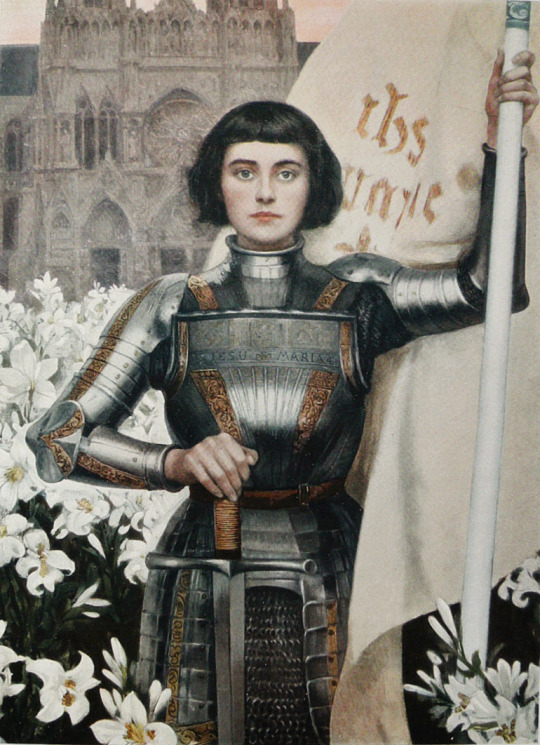
(Image Description: an engraving of Joan of Arc from 1903 by Peruvian artist Albert Lynch. It was featured in Figaro Illustre. It looks more like a painting than an engraving. It shows Joan in the center. In the background is Notre Dame. In the mid and foreground is a field of white flowers. Joan is front and center from the thighs up. She is in full plate mail but without the helmet or gloves. The armor has gold accents. She has pale skin and a round face. Her hair is black and cut into a bob with high bangs. One hand holds a flag and one hand rests on the hilt of a huge sword. She looks stoically and proudly out at the viewer. End ID.)
Joan of Arc is more legend than woman at this point, but she was very real. She is in part responsible for turning the tide of the Hundred Years War in France's favor. Now she is both French cultural heroine and canonized Catholic saint. Joan is an icon and inspiration and to millions be they French, Christian, woman, queer, or all of the above.
Joan's story is fairly well known. She was an illiterate peasant girl who, when she was 13, was visited by the visions of several saints. From that point forward she claimed to have been following God's instructions. At the time, France and England were still locked in the heat of the Hundred Years War (1337-1453) and the English occupied swaths of France. Eventually God told Joan to topple the English occupation and save France. She convinced the Dauphin to give her command over troops and dressed in men's armor Joan lead French victory after victory.
Although there were understandably doubts about what this untrained teenager could actually do she was able to convince naysayers quickly. She won first success at the Siege of Orléans. After the city was sieged for more than six months, Joan was able to turn away the English in only nine days. She was involved in more than a half dozen battles, many victories, between 1429 and 1431. These included the French success at the Battle of Patay and the March to Reims. During the latter she helped siege and reclaim several French cities and ensured the coronation of King Charles VII, at which she was in attendance.
She continued her campaign despite being injured in the Siege of Paris and was ultimately captured during the Siege of Compiègne. Her troops were outnumbered and her attempted surprise attack was rebuffed by English reinforcements, at which point she was overwhelmed and pulled from her horse.
She was captured, tried for witchcraft (although crossdressing was listed among her crimes/charges), and ultimately, horrifically, burned at the stake. Because she was so well loved the English made sure her body was very publicly destroyed both to avoid rumors of her escape and to make sure no relics could be made from her remains (as was very common for holy people at the time). Although English propaganda and court proceedings claimed Joan was a witch who spoke not to God and saints but to the Devil, her executioner still "greatly feared to be damned.". She was only 19 at the time of her death.
Joan has become a larger-than-life figure. Her story has been told and retold countless times over the centuries. Movies, books, plays, operas, songs, pieces of visual art. Nearly every medium that exists has depicted Joan of Arc in some capacity. For example, the first celluloid movie camera was invented in 1895, the first filmed depiction of Joan of Arc was made in only 1898. Mark Twain was very proud of his oft forgotten novel Personal Recollections of Joan of Arc. Voltaire wrote the poem "La Pucelle d’Orléans" (link goes to English translation) and there was a dramatic rebuttal by Die Jungfrau von Orleans (German) by Friedrich Schiller. Tchaikovsky wrote an opera The Maid of Orléans. George Bernard Shaw's Saint Joan is perhaps his magnum opus. Robert Southey and Samuel Taylor Coleridge wrote the epic "Joan of Arc". She is included in Shakespeare's Henry VI Part 1. The likes of Peter Paul Rubins, Paul Gauguin, John Everett Millais, Jean Auguste Dominique Ingres, among others have rendered Joan. She has been used for awards and propaganda.
Joan of Arc even impacted real life fashion, the Bob hairstyle's inventor based the now iconic look off Joan's haircut. It makes sense since the Bob was originally associated with the rebellious women of the 1920s. In 1920 she was canonized and is now the patron saint of France, soldiers, women in the WAVES and WAC, prisoners, among many others.
There is now speculation that Joan of Arc may have been mentally ill or had epilepsy.
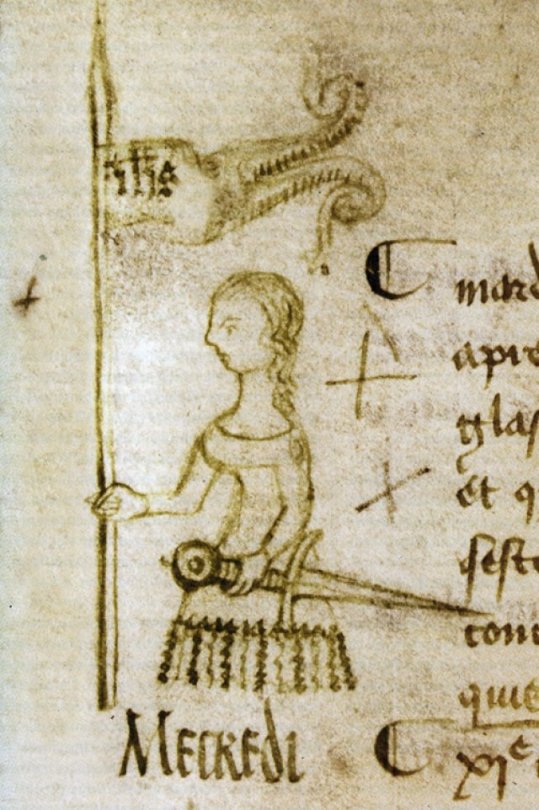
(Image Description: a drawing of Joan of Arc by Clément de Fauquembergue found in the margins of a parliamentary document from 1429. That makes this the earliest drawing of Joan we have. It is a brown ink drawing, slightly crude, very simple, of a woman drawn in profile. It ends just below her midsection. She wears a dress and carries as sword in one hand and a banner in the other. She is scowling. Oddly she does not have the short haircut that would become her trademark look, then again I have no idea how true/untrue to life this is. End ID)
Probable Orientation: Aroace (and obviously GNC. Crossdressing was one of the many crimes for which the English tried her.)
This is already a very long entry because of Joan of Arc's extensive legacy but it is going to get even longer, because I mentioned in Mary Eliza Mahoney's entry that there was another figure I was struggling with in my speculation, here she is. My biggest issue here was more moral than anything else.
Joan was only 19 when she died, that is hardly a full life to determine what her sexual orientation was. I do not object to a teenager self-identifying as any gender/sexual orientation, but it is quite another matter to impose one on them, especially when they died before being able to live a full life.
I thought a lot about the discourse presently surrounding Anne Frank. On my personal blog I have made my opinion abundantly clear (she is not your Bicon, she is a victim of a horrific genocide). So why is Joan different to me? I did some deep soul searching on this. So before going into my evidence as to why Joan of Arc may have been aroace.
The circumstances of their deaths are different. Anne was killed because of her ethnoreligious background in a campaign to wipe out the Jewish people. Joan was brutally killed for her gender and wearing men's clothing as much as she was for being an enemy general. Indeed, she would not have been burned alive had she been a young man doing exactly what Joan did and not a young woman. But her death is not representative of a larger narrative. There were no other Joans of Arc.
Yes, she is now a Catholic Saint, but unlike Anne Frank Joan was not killed for being Catholic and was killed by other Catholics. Also I should add Judaism is much larger than just a religion. It is an ethnicity as well. Joan was the same ethnicity (if not the same nationality) as her captors.
Anne was also a 20th century girl and 15 when she met her horrible demise. Joan's era and age are something I will expand on.
And importantly I am not the first person to ascribe queerness to Joan's story. She has been a queer figure for the better part of a century by now. Some scholars argue she was a lesbian*. Others say she was nonbinary**. Joan has long been important to the queer community, but that wouldn't necessarily make me right for adding to the debate.
But for Joan of Arc queerness is baked right in to the narrative. She wore men's clothing and broke gender norms, actions so taboo they were part of what cost her her life. Whether or not this crossdressing had anything to do with her gender or sexual orientation or just done for ease in battle is a subject of debate and boy howdy there is a lot of it. Plus, the actual act of going to war as a woman was an act of gender nonconformity.
Anyway now I am going to tell you why I believe Joan of Arc was an aroace, because it is another piece of the queerness of her narrative that she touted.
Here is one of the most important pieces of evidence to me, her name. Joan's birth name was Jehanne Darc (or a similar spelling), that was her father's surname and it was technically hers. In life she didn't use it. She called herself Jehanne la Pucelle (Joan the Maid) as in Joan the Virgin. That was the name she rallied her troops under. That was how her (dictated) letters were often signed. I have seen the argument made that she was asserting her purity, but it also would remind her troops of her age. Just like today "virgin" held a connotation of childishness. You were not married and inexperienced. Why would a military general want to point out how young she was? She had another name, she could have just been Jehanne Darc. It also told everyone she was a woman, including the enemy, who might use that against her. If she wanted to go with a nickname based on piousness it did not have to be "la Pucelle". There are many that did not imply either gender or age.
Her age is also important. Much like Wang Zhenyi she opted to break convention and do something else when it came time to get married. She was at war at the time when she should have been getting married, French women were generally married between 18 and 25. Her chasteness was noted in that she was only interested in carrying out God's Will. Nothing kept her on the battlefield except her dedication to her cause. She could have retired at any point. Indeed in September of 1429 she was badly injured by a crossbow bolt to the thigh, she had to be dragged from the battlefield and it was only by the king's orders that she did not return to it. She had a mission and marriage did not seem to factor into it. And that, being of marriageable age and not seeking it, would be odd even given her religiousness.
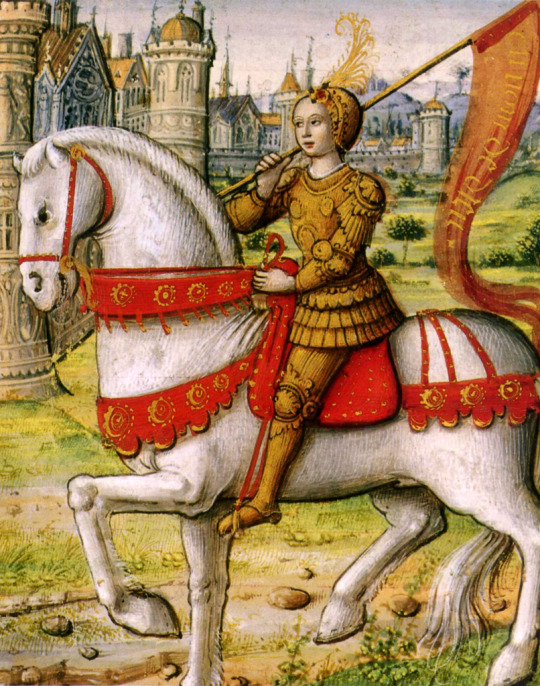
(Image Description: a 1504 painting of Joan on horseback. It is a bright painting on parchment. She is wearing shining armor with a yellow feather in her helmet. She carries a red banner. The horse is white with red and gold accoutrements and is prancing. There are fields and a castle behind her. Joan looks calm. End ID)
The argument could be made that it is impossible to untangle Joan's chastity from her religiousness. But I would argue that there is a way to tell and a way that hers is unique from that of other saints.
Within Catholicism chastity is about sacrifice and self-denial, by being sexless you are giving something up. That is why you will often see saints who are hermits, giving up sex along with everything else. Even saints who die as virgin martyrs (i.e. dying defending their virginity) are generally fending off rape or a marriage that would come between them and God. Unless they are willingly giving themselves up to God Himself chasteness is not supposed to last. Indeed, you are supposed to go forth and multiply and all that.
Officially in Catholic doctrine asexuality does not exist because sexual attraction (to the "opposite sex") is one of God's Gifts. It is impossible to not feel sexual attraction and be human in their eyes. As per an FAQ on religious life "Question: What do you call a person who is asexual? Answer: Not a person. Asexual people do not exist. Sexuality is a gift from God and thus a fundamental part of our human identity.". Or even more sinisterly as put by former Priest*** and Ugandan Ethics Minister Simon Lokodo when he said he approved of heterosexual child rape more than consentual gay sex "it is men raping girls. Which is natural" the implication being that hetero sex is the only "natural" thing, because even denial is unacceptable. Yes, Lokodo is an extreme example, but it reflects a mindset about heterosexual sex.
Chastity is only venerated in Christianity insofar as you are giving something up for God. The Christian faith has engineered the acceptable circumstances for sex and you are expected to have it and want it within those circumstances. Joan's maidenhood is traditionally viewed much the same way a nun's is, that she was driven by her love of God and her desire to fulfill His instructions and thus neglected her own desires. It is unthinkable that maybe she just didn't care, that she would rather be a warrior than a wife. She would be far less beloved if that was the widely agreed on conclusion, I assure you.
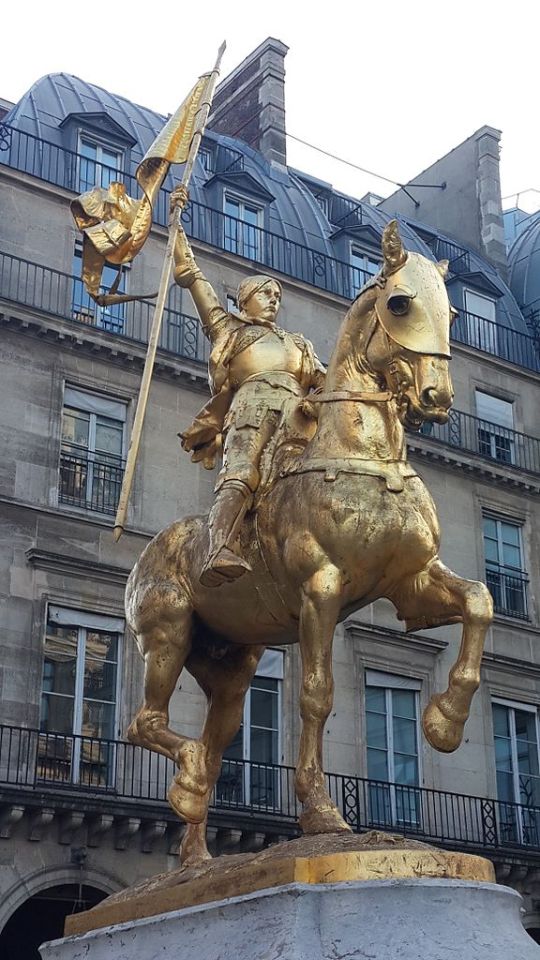
(Image description: Jeanne D'Arc (1874) a gilded bronze statue by Emmanuel Frémiet now at the Place des Pyramides, Paris. Commissioned by Napoleon III and standing 13 feet tall. It shows a triumphant Joan of Arc on horseback with her banner held high. Both she and her horse wear armor. End ID)
*The argument for this is actually pretty weak. The one thing I have seen used as evidence of her being definitively a lesbian is that she shared her bed with women. But this was the 15th century, bedsharing was extremely common, there weren't many beds to go around, whole peasant families might share a bed. Yes, it could mean something, but Occam's Razor, in an era when nonsexual bedsharing was common this is not proof this is was for sexual reasons, there is no reason Joan would be an exception. Without any other evidence she was a lesbian this is not enough to prove she was attracted to women. I am not saying it isn't possible, I am just saying that is not enough to go on.
**In her being GNC. Again, a possibility, but not definitive. Of course this stuff rarely is.
***He was removed from the priesthood when he entered politics as it is against Vatican law to hold both positions, it had nothing to do with his horrific stance on Queer Rights.
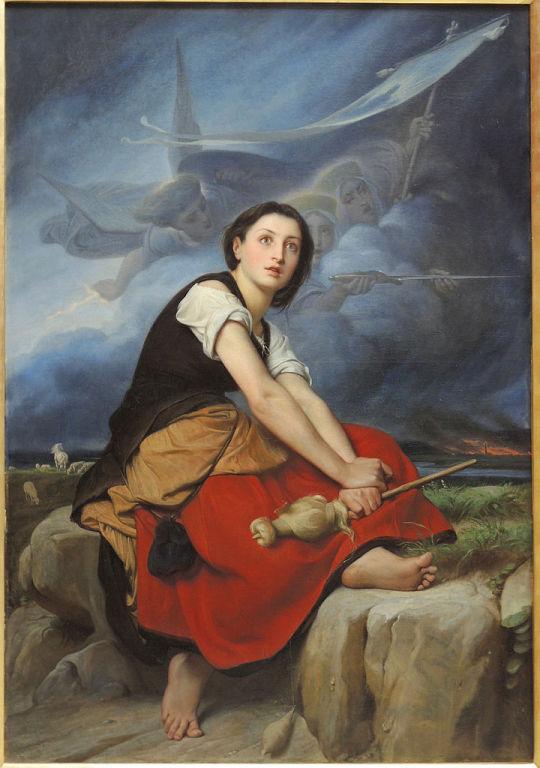
(Image Description: Jeanne d'Arc écoutant ses voix by Léon François Bénouville [done before 1859]. It is a painting that shows Joan when she first was visited by Saints/Angels. It shows Joan in layered but undecorated clothing. She is clutching what appears to be part of a loom or other wool working equipment in one hand. The other holds her wrist. She is white and pale and barefoot. Her hair is dark and partially pinned back, starting to come free. She has a round face and looks shocked, her doll like mouth agape in a gasp and her light eyes wide. She is seated on a rock with a field behind her, dotted with sheep and a horse. Far beyond her in the distance is a burning city. In the air around her in an immense sky are the flying and translucent forms of angels. They have their mouths open, calling to her. One offers her a sword another carries a flag/banner. End ID.)
Quotes:
"Jehanne la Pucelle"
-How Joan signed her dictated letters and referred to herself, "Joan the Maid".
"Alas! that my body, clean and whole, never been corrupted, today must be consumed and burnt to ashes!"
-Joan of Arc after being condemned to death, quoted by Jean Toutmouille
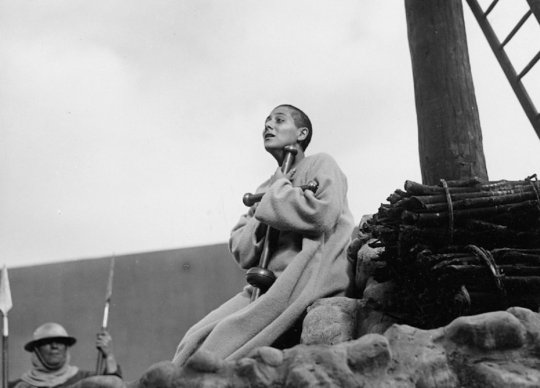
(Image Description: a still from La Passion de Jeanne d'Arc (The Passion of Joan of Arc) a silent film from 1928. It is widely regarded as a masterpiece and a landmark of early cinema. Renée Jeanne Falconetti (Joan) is still hailed for her performance. In this image we see Joan kneeling in front of the stake. She is wearing a wool robe and clutching a cross. The anguish on her face is indescribable. Behind her is an armed guard. End ID)
#lgbtq#queer#asexual#ace#history#aromantic#aro#soldiers#Europe#French#15th century#Joan of Arc#France#bio
59 notes
·
View notes